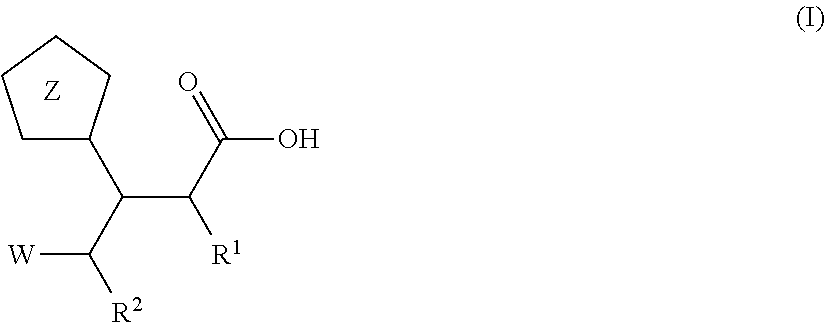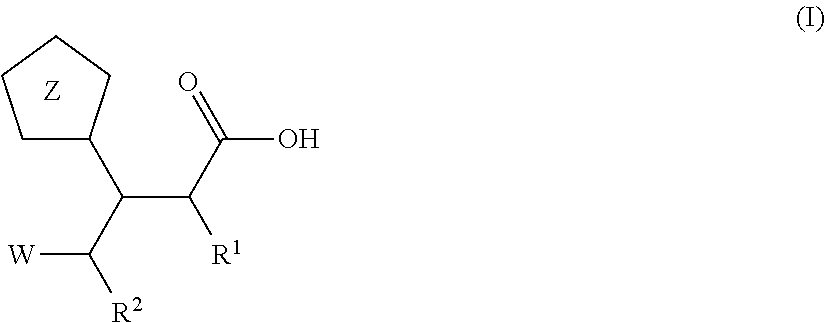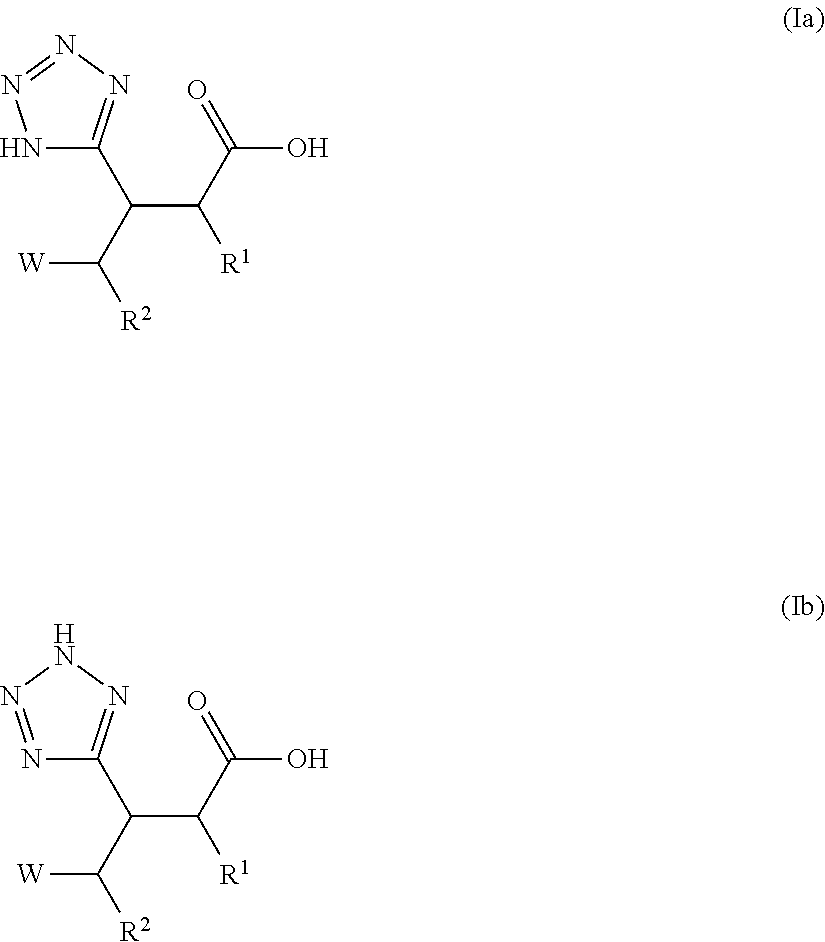Beta-tetrazolyl-propionic acids as metallo-beta-lactamase inhibitors
a technology of metallolactamase inhibitors and tetrazolylpropionic acids, which is applied in the direction of organic active ingredients, organic chemistry, organic chemistry, etc., can solve the problems of increasing mortality, long hospital stay, and increasing antibiotic resistance of bacteria, so as to achieve the effect of synergizing the antibacterial effect and inhibiting the growth of bacteria
- Summary
- Abstract
- Description
- Claims
- Application Information
AI Technical Summary
Benefits of technology
Problems solved by technology
Method used
Image
Examples
examples 1-2
[0570]
(S)-6-Methyl-2-((S)-2-phenyl-1-(1H-tetrazol-5-yl)ethyl)heptanoic acid and (R)-6-methyl-2-((S)-2-phenyl-1-(1H-tetrazol-5-yl)ethyl)heptanoic acid
Step A: (2S)-2-benzyl-3-(tert-butoxycarbonyl)-7-methyloctanoic acid
[0571]Intermediate (S)-2-benzyl-4-(tert-butoxy)-4-oxobutanoic acid was prepared according to the literature methods (Synthetic communications, 2004, 2633-2640). To a stirred solutions of (S)-2-benzyl-4-(tert-butoxy)-4-oxobutanoic acid (164 mg, 0.620 mmol) in THF (1.5 ml) at −78° C., was added slowly LHMDS (1.6 ml, 1.6 mmol). The solution was stirred at −78° C. for 1 hour, and then 1-iodo-4-methylpentane (250 mg, 1.2 mmol) was added slowly, stirred at −78° C. for 1 hour, and then warmed to 0° C. and stirred for 3 hrs, and then at RT for 3 hrs. The solution was quenched with sat. NH4Cl at 0° C., extracted with EtOAc, dried over Na2SO4, and evaporated to dryness to give the crude product. The crude was used in Step B.
Step B: tert-butyl 2-((S)-1-amino-1-oxo-3-phenylpropan-2-...
example 3
[0578]
(2S,3S)-2-benzyl-4-phenyl-3-(1H-tetrazol-5-yl)butanoic acid
Step A: (2S,3S)-tert-butyl 2-benzyl-4-phenyl-3-(1H-tetrazol-5-yl)butanoate
[0579]To a stirred solution of (S)-tert-butyl 4-phenyl-3-(1H-tetrazol-5-yl)butanoate (75 mg, 0.26 mmol) in THF (1 ml) at −78° C., was added slowly LDA (0.32 ml, 0.65 mmol). The solution was stirred at −78° C. for 0.7 hour, then benzyl bromide (0.124 ml, 1.04 mmol) was added slowly, stirred at −78° C., and then slowly warmed to RT and stirred overnight. The solution was quenched with saturated NH4Cl at RT, extracted with EtOAc, dried over Na2SO4, filtered and evaporated to dryness. The crude was used directly in Step B.
Step B: (2S,3S)-2-benzyl-4-phenyl-3-(1H-tetrazol-5-yl)butanoic acid
[0580]The crude containing (2S,3S)-tert-butyl 2-benzyl-4-phenyl-3-(1H-tetrazol-5-yl)butanoate (98 mg, 0.26 mmol) from Step A was dissolved in dichloromethane (1.7 ml), thioanisole (0.61 ml, 5.2 mmol) followed by TFA (1.3 ml, 17 mmol). The reaction was stirred at RT o...
examples 4-26
[0581]
Step A: (S)-tert-butyl 2-((S)-2-phenyl-1-(1H-tetrazol-5-yl)ethyl)pentanoate
[0582]To a stirred solution of (S)-tert-butyl 4-phenyl-3-(1H-tetrazol-5-yl)butanoate (84 mg, 0.29 mmol) in THF (1 ml) at −78° C., was added slowly LDA (0.37 ml, 0.73 mmol). The solution was stirred at −78° C. for 0.5 hour, then 1-iodopropane (0.15 ml, 1.46 mmol) was added slowly, stirred at −78° C. for 30 mins, and then slowly warmed to RT and stirred overnight. The solution was quenched with sat. NH4Cl at RT, extracted with EtOAc, dried over Na2SO4, filtered and evaporated to dryness. The crude was purified by silica gel column chromatography, eluted with EtOAc-hexane (0-100%) to yield the product.
Step B: (R)-2-((S)-2-phenyl-1-(1H-tetrazol-5-yl)ethyl)pentanoic acid and (S)-2-((S)-2-phenyl-1-(1H-tetrazol-5-yl)ethyl)pentanoic acid
[0583]To a stirred solution of tert-butyl 2-((S)-2-phenyl-1-(1H-tetrazol-5-yl)ethyl)pentanoate (44 mg, 0.13 mmol) in toluene (1.2 ml) was added TFA (1.8 ml, 23 mmol). The soluti...
PUM
| Property | Measurement | Unit |
|---|---|---|
| Force | aaaaa | aaaaa |
| Force | aaaaa | aaaaa |
| Force | aaaaa | aaaaa |
Abstract
Description
Claims
Application Information
 Login to View More
Login to View More - R&D
- Intellectual Property
- Life Sciences
- Materials
- Tech Scout
- Unparalleled Data Quality
- Higher Quality Content
- 60% Fewer Hallucinations
Browse by: Latest US Patents, China's latest patents, Technical Efficacy Thesaurus, Application Domain, Technology Topic, Popular Technical Reports.
© 2025 PatSnap. All rights reserved.Legal|Privacy policy|Modern Slavery Act Transparency Statement|Sitemap|About US| Contact US: help@patsnap.com



